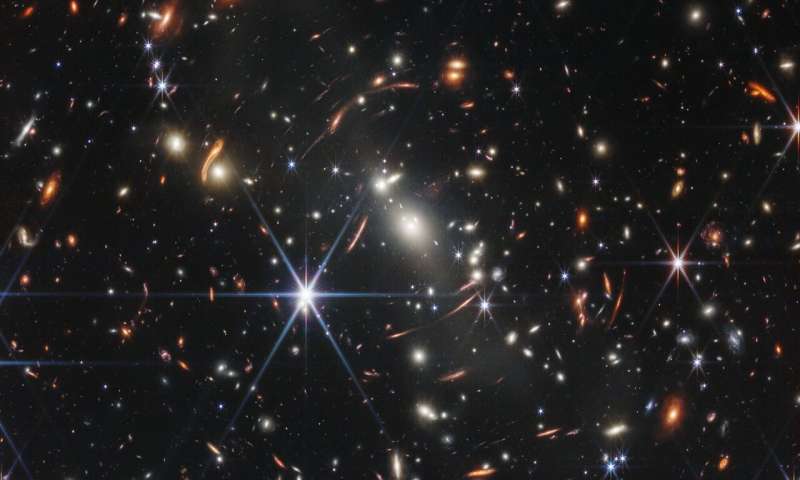 The galaxy cluster SMACS 0723 as seen by NIRCam on JWST. It’s gravitational lensing properties (from its mass and from the mass of dark matter) are helping astronomers identify 88 distant galaxies in this field of view for further study. Credit: NASA, ESA, CSA, STScI
The galaxy cluster SMACS 0723 as seen by NIRCam on JWST. It’s gravitational lensing properties (from its mass and from the mass of dark matter) are helping astronomers identify 88 distant galaxies in this field of view for further study. Credit: NASA, ESA, CSA, STScI
Clusters of galaxies do not appear in an instant. Instead they gradually form through the accumulation of many galaxies. But when galaxies fall in they don’t just stop moving. Instead, they keep moving around. These are called backsplash galaxies, and astronomers are using them to help understand the formation history of their home clusters.
Clusters of galaxies are the largest gravitationally bound structures in the universe. They slowly emerge over the course of billions of years by gravitationally attracting any nearby galaxies (plus plenty of other matter). Those galaxies then fall into the cluster, but due to their incredible speeds they don’t just stop when they reach the cluster. Oftentimes they will swing near the center of the cluster and keep going. They are trapped in the cluster forever, but they don’t stay still, forced to constantly swing back and forth for eternity.
Imagine kicking a ball down a one side of a valley and watching it reach the bottom, then climb back up the other side. The ball won’t leave the valley, but it will keep rolling back and forth until it settles down—this is what galaxies experience at a much larger scale.
Astronomers believe that galaxies that have already passed through the core of the cluster once, known as backsplash galaxies, will be slightly different than galaxies that are just now falling in. To test this idea a team of astronomers recently examined a series of clusters with data taken from the Sloan Digital Sky Survey. They used the velocities of galaxies inside those clusters to separate them into in-falling galaxies and backsplash galaxies.
Credit: arXiv (2023). DOI: 10.48550/arxiv.2301.01776
They found that backsplash galaxies were consistently older, meaning that they had a lower fraction of young stars inside them. The backsplash galaxies also tended to be quieter in terms of overall seller activity than their in-falling cousins.
The astronomers behind the study hypothesize that when backsplash galaxies first encounter the dense environments of the inner cluster, this ramps up star production inside the galaxies. This eats up a lot of usable gas to make future generations of stars, and so when galaxies climb their way back out to the other side of the cluster they have less fuel and so make stars at a far slower pace.
Further understanding the relationship between in-falling and backsplash galaxies will help astronomers piece together the complicated lives of these massive clusters of galaxies.
The findings are published on the arXiv preprint server.
Provided by Universe Today








